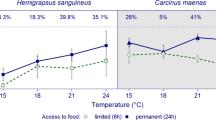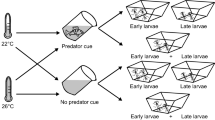Abstract
Mud from a temporary pool in Morocco was sequentially inundated and dried at the laboratory to follow the life history of Branchipus schaefferi. Once adult, each female was coupled to a male in order to study their life history and reproduction. The average percentage of hatching decreased during the successive inundations, presumably as an adaptation to the unpredictability of the habitat. However, there was no indication that the offspring of the first inundation would preferentially hatch during their first inundation too, neither was there any such preference in the offspring of the delayed hatchings. Each female reduced risk by spreading hatching time of her resting eggs over consecutive inundations. Eggs did not hatch all at the same moment, reducing the chance that a female’s entire offspring would die before reaching maturity if the pool would dry out too soon. There was a significant difference between the mean value of the number of resting eggs produced by the females from a large clutch size, and those produced by females from a small clutch size. There thus appears to be a genetic base for the clutch size of females.





Similar content being viewed by others
References
Atashbar, B., N. Agh, L. Beladjal, R. Jalili & J. Mertens, 2012. Effect of temperature on survival, growth, reproductive and life span characteristics of Branchinecta orientalis G.O. Sars, 1901 (Branchiopoda, Anostraca) from Iran. Crustaceana 85: 1099–1114.
Atashbar, B., N. Agh, G. Van Stappen, J. Mertens & L. Beladjal, 2014. Combined effect of temperature and salinity on hatching characteristics of three fairy shrimp species (Crustacea: Anostraca). Journal of Limnology 73: 574–583.
Belk, D. & J. Brtek, 1995. Cheklist of the Anostraca. Hydrobiologia 298: 315–353.
Beladjal, L., J. Mertens & H. J. Dumont, 1995. An analysis of the setation pattern of the limbs in Anostraca (Crustacea), using the Algerian species as an example. Hydrobiologia 298: 183–201.
Beladjal, L., T. M. M. Vandekerckhove, B. Muyssen, J. Heyrman, J. De Caesemaeker & J. Mertens, 2002. B-chromosomes and male-biased sex ratio with paternal inheritance in the fairy shrimp Branchipus schaefferi (Crustacea, Anostraca). Heredity 88: 356–360.
Beladjal, L., N. Peiren, T. M. M. Vandekerckhove & J. Mertens, 2003. Differents life histories of the co-occuring fairy shrimps Branchipus schaefferi and Streptocephalus torvicornis (Anostraca). Journal of Crustacean Biology 23: 300–307.
Beladjal, L., P. H. H. Weekers & J. Mertens, 2007a. Life cycle and genetic differences of two Branchipus schaefferi populations from Morocco (Anostraca: Crustacea). Animal Biology 57: 409–421.
Beladjal, L., K. Dierckens & J. Mertens, 2007b. Pheromones inhibit the hatching of diapausing Anostraca (Crustacea: Branchiopoda). Animal Biology 57: 1–9.
Beladjal, L., J. Mertens & J. Clegg, 2008. Biochemical and biophysical aspects of the tolerance of anhydrobiotic crustacean embryos to very high temperatures. Journal of Thermal Biology 33: 117–127.
Brendonck, L., 1996. Diapause, quiescence, hatching requirements: what we can learn from large freshwater branchiopods (Crustacea: Branchiopoda: Anostraca, Notostraca, Conchostraca). Hydriobiologia 320: 85–97.
Cvetković-Miličić, D., B. Petrove & I. Z. Petrove, 2005. New evidence indicating the presence of the genus Branchipus Schaeffer, 1766 (Crsutacea, Branchiopoda) in the Eastern Balkans. Archive of Biological Sciences Belgrade 57: 11–12.
Dimentman, C., 1981. The rainpool ecosystems of Israel: geographical distribution of freshwater Anostraca (Crustacea). Israel Journal of Zoology 30: 1–15.
Eder, E., W. Hödl & R. Gottwald, 1997. Distribution and phenology of large branchiopods in Austria. Hydrobiologia 359: 13–22.
Fryer, G., 1996. Diapause, a potent force in the evolution of freshwater crustaceans. Hydrobiologia 320: 1–14.
Gharibi, M. R., M. A. Nematollahi, N. Agh & B. Atashbar, 2016. Life cycle of the fairy shrimp, Phallocryptus spinosa Milne Edwards, 1840 (Crustacea: Anostraca) at different temperatures. Journal of Agricultural Science and Technology 18: 171–177.
Gyllström, M. & L. Hansson, 2004. Dormancy in freshwater zooplankton: Induction, termination and the importance of benthic-pelagic coupling. Aquatic Sciences 66: 274–295.
Hildrew, A. G., 1985. A quantitative study of the life history of a fairy shrimp (Branhiopoda: Anostraca) in relation to the temporary nature of its habitat, a Kenyan rainpool. Journal of Animal Ecology 54: 99–110.
Jönsson, K. I. & J. Järemo, 2003. A model on the evolution of cryptobiosis. Annales of Zoology Fennici 40: 331–340.
Korinkova, T. & B. Goldyn, 2011. Karyotypes and sex ratios in populations of Eubranchipus grubii (Dybowski, 1860) and Branchipus schaefferi Fischer, 1834 (Branchiopoda, Anostraca) from Poland. Crustaceana 84: 707–720.
Maffei, C., D. Vagaggini, P. Zarattini & G. Mura, 2004. The dormancy problem for Crustacea Anostraca: a rigorous model connecting hatching strategies and environmental conditions. Ecological Modelling 185: 469–481.
McFadden, L. D., M. C. Eppes, A. R. Gillespie & B. Hallet, 2005. Physical weathering in arid landscapes due to diurnal variation in the direction of solar heating. GSA Bulletin 117: 161–173.
Mertens, J., L. Beladjal, A. Alcantara, L. Fougnies, D. Van Der Straeten & J. S. Clegg, 2008. Survival of dried eukaryotes (anhydrobiotes) after exposure to very high temperatures. Biological Journal of the Linnean Society 93: 15–22.
Mura, G., 1997. The life history of Chirocephalus kerkyrensis Pesta (Crustacea: Anostraca) in temporary waters of Circeo National Park (Latium, Italy). Hydrobiologia 346: 11–23.
Mura, G., 1999. Current status of the Anostraca in Italy. Hydrobiologia 405: 57–65.
Mura, G., 2001. Life history strategy of Chirocephalus ruffoi (Crustacea, Anostraca) in Mediterranean temporary mountain pools. Hydrobiologia 462: 145–156.
Mura, G., 2004. Structure and Functioning of the “Egg Bank” of a Fairy Shrimp in a Temporary Pool: Chirocephalus ruffoi from Pollino National Park (Southern Italy) as a case study. International Review of Hydrobiology 89: 35–50.
Petkovski, S., 1997. On the presence of the genus Branchipus Schaeffer, 1766 (Crustacea: Anostraca) in Macedonia. Hydrobiologia 359: 37–44.
Petrov, B. & D. M. Cvetković, 1997. Community structure of branchiopods (Anostraca, Notostraca and Conchostraca) in the Banat province in Yugoslavia. Hydrobiologia 359: 23–28.
Petrov, B. & I. Petrov, 1997. The status of Anostraca, Notostraca and Conchostraca (Crustacea: Branchiopoda) in Yugoslavia. Hydrobiologia 359: 29–35.
Thiéry, A., 1991. Multispecies coexistence of branchiopods (Anostraca, Notostraca & Spinicaudata) in temporary ponds of Chaouia plain (western Morocco): sympatry or syntopy between usually allopatric species. Hydrobiologia 212: 117–136.
Thiéry, A., 1997. Horizontal distribution and abundance of cysts of several large branchiopods in temporary pool and ditch sediments. Hydrobiologia 359: 177–189.
Wolf, M., G. S. Van Doorn, O. Leimar & F. J. Weissing, 2007. Life-history trade-offs favour the evolution of animal personalities. Nature 447: 581–585.
Acknowledgments
Paola Zarattini (Università degli Studi di Trieste, Italy) and one anonymous referee are acknowledged for providing constructive comments on the manuscript. We thank Prof Gilbert Van Stappen (Ghent University, Belgium) for having the kindness to improve the English language.
Author information
Authors and Affiliations
Corresponding author
Additional information
Guest editors: Federico Marrone, D. Christopher Rogers, Paola Zarattini & Luigi Naselli-Flores / New Challenges in Anostracan Research: a Tribute to Graziella Mura
Rights and permissions
About this article
Cite this article
Beladjal, L., Mertens, J. Risk reduction strategies in Branchipus schaefferi (Crustacea: Anostraca: Branchiopoda) as adaptation to a variable environment. Hydrobiologia 801, 153–163 (2017). https://doi.org/10.1007/s10750-017-3156-9
Received:
Revised:
Accepted:
Published:
Issue Date:
DOI: https://doi.org/10.1007/s10750-017-3156-9




